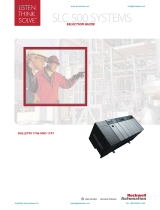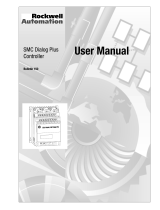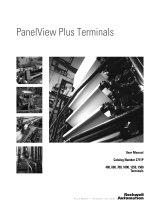Page is loading ...

Publication 1747-5.33
Remote I/O Scanner
Catalog Number 1747-SN
Installation Instructions

2 Remote I/O Scanner
Publication 1747-5.33
Important User Information
Because of the variety of uses for the products described in this publication, those
responsible for the application and use of this control equipment must satisfy
themselves that all necessary steps have been taken to assure that each
application and use meets all performance and safety requirements, including any
applicable laws, regulations, codes and standards.
The illustrations, charts, sample programs and layout examples shown in this
guide are intended solely for purposes of example. Since there are many
variables and requirements associated with any particular installation, Allen-
Bradley does not assume responsibility or liability (to include intellectual
property liability) for actual use based upon the examples shown in this
publication.
Allen-Bradley publication SGI-1.1, Safety Guidelines for the Application,
Installation, and Maintenance of Solid-State Control (available from your local
Allen-Bradley office), describes some important differences between solid-state
equipment and electromechanical devices that should be taken into consideration
when applying products such as those described in this publication.
Reproduction of the contents of this copyrighted publication, in whole or in part,
without written permission of Allen-Bradley Company, Inc., is prohibited.
Throughout this manual we use notes to make you aware of safety
considerations:
Attention statements help you to:
• identify a hazard
• avoid the hazard
• recognize the consequences
!
ATTENTION: Identifies information about practices
or circumstances that can lead to personal injury or
death, property damage or economic loss.
Important: Identifies information that is critical for successful
application and understanding of the product.

Remote I/O Scanner 3
Publication 1747-5.33
For More Information
As part of our effort to preserve, protect, and improve our environment, Allen-
Bradley is reducing the amount of paper we use. Less paper means more options
for you. In addition to traditional printed publications and CD-ROM versions,
we now offer online materials with the most up-to-date information you can get.
We recommend that you read the related publications listed below before starting
up your control system.
Related Publications
How to Get More Information
For Refer to this Document Pub. No.
A more detailed description on how to
install, configure, and operate your
Remote I/O Scanner.
Remote I/O Scanner
User Manual
1747-6.6
A more detailed description on how to
install and use your modular
SLC 500™ system
SLC 500 Modular Hardware Style
Installation and Operation Manual
1747-6.2
A reference manual that contains
status file data and instruction set
information for SLC 500 processors.
SLC 500™ and MicroLogix™
1000 Instruction Set Reference
Manual
1747-6.15
For Obtain Information By
Fast access to related
publications
• Visiting the Automation Bookstore at
http://www.theautomationbookstore.com — Electronic versions of
our manuals are available for you to search and download.
• Calling (440) 646-5436 for the Allen-Bradley Fax Back service. You
will be faxed information on the topic you request.
Publications in printed
format
Ordering a manual using one of the following methods:
• Filling out and returning the User Manual Request Card that was
shipped with the unit.
• Visiting the Automation Bookstore at
http://www.theautomationbookstore.com
Multiple copies of a
manual
• Visiting the Automation Bookstore at
http://www.theautomationbookstore.com

4 Remote I/O Scanner
Publication 1747-5.33
Overview
The Remote I/O (RIO) Scanner, 1747-SN, enables communication between an
SLC™ processor and remotely located 1746 I/O chassis and other RIO-
compatible Allen-Bradley operator interface and control devices. The 1747-SN
scanner communicates with remote devices using the A-B Remote I/O link. The
RIO link consists of a single master (scanner) and multiple slaves (adapters).
Communication between devices occurs over twisted-pair cable with the devices
daisy-chained together. Maximum distance for remote communication is
3,048 m (10,000 ft.). The scanner is compatible with any standard RIO adapter
device.
The SLC processor transfers a maximum of 4 logical racks (32 input and 32
output image words) of discrete remote I/O data into the SLC input and output
image files. You can adjust the size of the scanner image files during
configuration of your SLC system so that the scanner only transfers the discrete
I/O data required by your application program. The 1747-SN Series B or later
RIO Scanner can be configured to transfer up to 64 words of data to a remote
device via block transfer. Refer to publication 1747-6.6, Remote I/O Scanner
User Manual, for information on configuration, programming, and block
transfers.
The SLC 500™ processor (SLC 5/02™ or higher) supports multiple scanners in
its local I/O chassis. The maximum number is dependent on the following:
• backplane power requirements (power supply dependent)
• SLC 500 processor I/O data table limit (4,096 input and output bits)
• processor memory to support the application (SLC processor dependent)
RIO Scanner
(Master of the RIO Link)
SLC 5/02 or
later processor
1747-ASB Module
(Adapter/Slave)
Remote Chassis
Remote
Expansion Chassis
Dataliner
™
Message Display
(Adapter/Slave)
PanelView
™
Operator Terminal
(Adapter/Slave)
RediPANEL
™
(Adapter/Slave)
Local SLC Chassis

Remote I/O Scanner 5
Publication 1747-5.33
Hardware Features
The figure below shows the scanner’s features. RIO Link Connector, Status
LED, and DIP Switch information follows.
RIO Link Connector
This 3-pin male connector connects the scanner to the RIO link. The
Allen-Bradley repair part number is 1746-RT29.
SCANNER
1
2
12
Dip Switch
Cable Tie Slots
RIO Link Connector
Status
LEDs
SW1
Line 1
Shield
Line 2
ON
ON
OFF
OFF
57.6
115.2
230.4
230.4
ON
OFF
ON
OFF
1 2 KBAUD
CONNECT ONE END OF
CABLE SHIELD TO CHASSIS
MOUNTING BOLT. REFER TO
USERS MANUAL.
COMM FAULT
1747-SN
SA
U
L
LISTED IND. CONT. EQ.
FOR HAZ. LOC. A196
OPERATING
TEMPERATURE
CODE T3C
CLASS I, GROUPS A, B, C, AND D, DIV 2
SLC 500
Remote I/O Scanner
CAT
SERIAL NO. FAC
SER
HOST
FRN
PLUG
FRN
MADE IN U.S.A.
B
CURRENT REQUIREMENT 600 mA @ 5VDC
O
N
O
N

6 Remote I/O Scanner
Publication 1747-5.33
Status LEDs
The scanner has two LEDs, FAULT and COMM, which indicate its operating
status.
FAULT LED - indicates the scanner’s overall status. The red FAULT LED
is off whenever the scanner is configured and operating properly.
COMM LED - allows you to monitor communication with all configured
devices. This LED is green once the scanner is in the Run mode. It is red if
a hardware fault is detected. The COMM LED status information is valid
only when the FAULT LED is off.
The table below explains the scanner and communication status as indicated by
the FAULT and COMM LEDs.
FAULT LED COMM LED Status Information
Flashing
Red
Not
applicable
Scanner configuration error.
No RIO link communication attempted.
Duplicate scanner detected on RIO link.
Red
Not
applicable
Major fault on scanner.
No RIO link communication attempted.
Off Red Hardware fault detected.
Off Off
Scanner is operating properly.
Scanner is offline (no RIO link communication attempted).
Off Green Scanner is operating properly.
Scanner is online (active communication established with all
devices).
Off
Flashing
Green
Scanner is operating properly.
At least one configured RIO link device is not communicating.
Off
Flashing
Red
Scanner is operating properly.
None of the configured RIO link devices are communicating.

Remote I/O Scanner 7
Publication 1747-5.33
Baud Rate DIP Switch
The figure below shows the location of the DIP switch and the DIP switch
settings for the supported baud rates.
Required Tools and Equipment
Have the following tools and equipment ready:
• medium blade screwdriver
• termination kit (the package, containing resistors and a ring lug, which was
included with the scanner)
• approximately 38 cm (15 inches) of #20 AWG wire for grounding the drain
shield to the SLC chassis (for Series A retrofits)
• adequate length of RIO communication cable (Belden™ 9463) for your
specific application
Important: For proper system operation, the baud rate of all devices
on the RIO link must be the same.
12
12
12
12
57.6K baud
115.2K baud
230.4K baud
230.4K baud
O
N
O
N
O
N
O
N

8 Remote I/O Scanner
Publication 1747-5.33
Installation
Make sure you have set the DIP switch properly before installing the scanner.
Insertion
1. Disconnect power.
2. Align the full-sized circuit board with the chassis card guides. The first slot
(slot 0) of the first rack is reserved for the SLC 500 processor.
3. Slide the module into the chassis until the top and bottom latches catch.
4. Attach the RIO link cable to the connector on the front of the module,
behind the door. Ground the cable’s shield wire to a chassis mounting
bracket. Refer to the RIO link wiring illustration on page 10.
!
ATTENTION: Disconnect system power before
attempting to install, remove, or wire the module.
Important: Before installation, make sure that your modular SLC
power supply has adequate reserve current capacity. The
scanner requires 600 mA at 5V dc.
Card Guide
Module Release
Cable Tie

Remote I/O Scanner 9
Publication 1747-5.33
5. Insert the cable tie in the slots.
6. Route the cable down and away from module, securing it with the cable tie.
7. Cover all unused slots with the Card Slot Filler, Catalog Number 1746-N2.
Removal
1. Disconnect power.
2. Remove all cabling.
3. Press the releases at the top and bottom of the module and slide the module
out of the chassis slot.
4. Cover all unused slots with the Card Slot Filler, Catalog Number 1746-N2.
RIO Link Wiring
The scanner is connected to other devices on the RIO link in a daisy chain (serial)
configuration. There are no restrictions governing the space between each
device, provided the maximum cable distance (Belden™ 9463) is not
exceeded.A 1/2 watt terminating resistor (included with the module) must be
attached across line 1 and line 2 of the connectors at each end (scanner and last
physical device) of the RIO link. The size of the resistor depends on the baud
rate and extended node capability, as shown in the table below.
Note:
To use extended node, all devices on the RIO link must support it. Refer
to each device’s user manual.
Baud Rate
Max. Cable Distance
(Belden 9463)
Resistor Size
Using Extended
Node Capability
57.6K baud 3048 m (10,000 ft.)
82
Ω
1/2 Watt
Gray-Red-Black-Gold
115.2K baud 1524 m (5,000 ft.)
230.4K baud 762 m (2,500 ft.)
Not Using
Extended Node
Capability
57.6K baud 3048 m (10,000 ft.)
150
Ω
1/2 Watt
Brown-Green-Brown-Gold
115.2K baud 1524 m (5,000 ft.)
230.4K baud 762 m (2,500 ft.)
82
Ω
1/2 Watt
Gray-Red-Black-Gold

10 Remote I/O Scanner
Publication 1747-5.33
For New Installations
To ensure a proper earth ground of the cable shield, follow these steps:
1. While the RIO link connector is plugged into the scanner and lines 1 and 2
are connected, strip the cable back to expose enough shield drain wire to
reach a chassis mounting bracket.
2. Attach the ring terminal lug (supplied) to the end of the shield drain wire.
3. Attach the ring terminal lug to the SLC chassis mounting bracket. Note that
for new installations the middle (shield) terminal is not used when
connecting to the scanner.
Important: The RIO cable shield must be grounded at the scanner
end only.
RIO Scanner
Chassis Mounting
Bracket
Ring Lug
Shield
Drain Wire
(For New Series B Installations)
Shield Drain Wire
(For Series A Retrofits)
RIO Link
Connector
Terminating
Resistor
Scanner End
Terminating Resistor
Last Physical Device End
Line 1 – Blue
Shield – Shield
Line 2 – Clear
RIO Link
Connector

Remote I/O Scanner 11
Publication 1747-5.33
For Series A Scanner Retrofits
Refer to the illustration on page 10. To eliminate the need to strip the cable back,
follow these steps:
1. Attach the shield wire and a short piece of #20 AWG wire (dotted line) to
the shield lug of the RIO link connector.
2. Attach the other end of the #20 AWG wire to the ring terminal lug.
3. Attach the ring terminal lug to a chassis mounting bracket.
Specifications
Important: The RIO cable shield must be grounded at the scanner
end only. Ensure that the unshielded portion of the link
communication wire (blue and clear) is as short as
possible.
Backplane Current Consumption 600 mA at 5V dc
Operating Temperature 0°C to +60°C (+32°F to +140°F)
Storage Temperature -40°C to +85°C (-40°F to +185°F)
Humidity 5 to 95% without condensation
Noise Immunity NEMA Standard ICS 2-230
Agency Certification
UL listed / CSA Certified
Class I, Division 2, Groups A,B, C, D
CE marked for all applicable directives

Publication 1747-5.33 – August 1998 40071-039-01(A)
1998 Rockwell International. All Rights Reserved. Printed in USA
PLC is a registered trademark of the Rockwell Automation, Inc.
SLC, SLC 500, SLC 5/02, PanelView, RediPANEL, Dataliner, Flex I/O, PLC–5/15, PLC–5/12,
PLC–5/25, PLC–5/30, PLC–5/40, PLC–5/60 are trademarks of Rockwell Automation, Inc.
Belden is a trademark of Belden, Inc.
/






